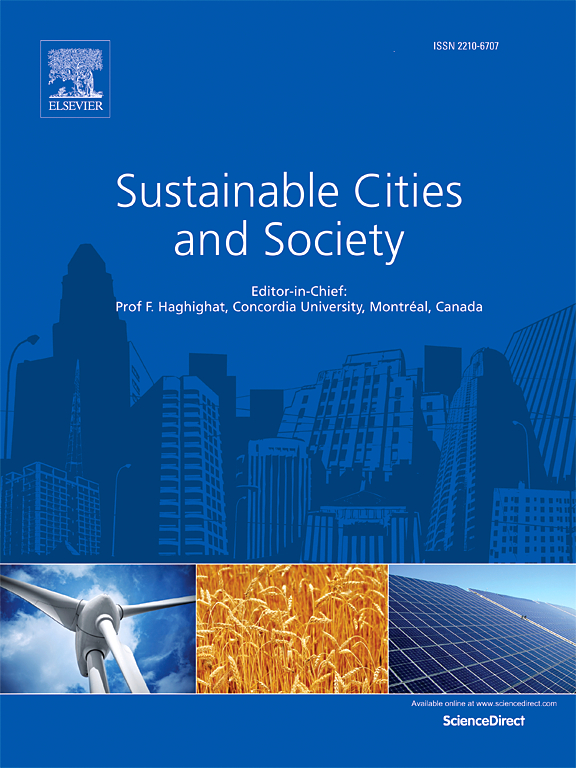中国智慧城市政策对城市绿色增长的影响评估:城市韧性的中介作用
IF 10.5
1区 工程技术
Q1 CONSTRUCTION & BUILDING TECHNOLOGY
引用次数: 0
摘要
本文利用2003 - 2021年中国280个地级以上城市的面板数据,利用超高效SBM-GML模型估算了城市绿色增长,并利用时变差中差(TV-DID)模型评估了智慧城市政策(SCP)对城市绿色增长的影响。此外,本文系统地考察了城市韧性对绿色全要素生产率(GTFP)的影响,并利用中介分析阐明了城市韧性对智慧城市发展和GTFP的影响机制。研究发现:(1)SCP通过增强技术效应、配置效应和结构效应来促进GTFP。(2) UR显著提高了城市的GTFP。具体而言,经济弹性通过技术进步和产业升级促进GTFP,而社会弹性通过绿色创新促进GTFP。生态弹性通过基础设施建设和政府干预提高GTFP,而基础设施弹性有助于缓解劳动力错配和改善人力资本,从而促进全要素生产率的增长。(3) UR在SCP与GTFP之间起中介作用。(4)异质性分析表明,区域、资源禀赋和城市规模对GTFP的SCP和UR影响存在差异。东部地区的政策效应明显强于中西部地区;资源型城市比非资源型城市效应更明显;超级城市比非超级城市受到更强的政策影响。最后,根据经验证据,概述了具体的政策建议。本文章由计算机程序翻译,如有差异,请以英文原文为准。
Assessing smart cities policy on urban green growth in China: The mediating effect of urban resilience
Using panel data of 280 cities above prefecture-level in China between 2003 and 2021, this paper estimates the urban green growth by the super-efficient SBM-GML model and assesses the impact of smart city policy (SCP) on urban green growth by utilizing the time-varying difference-in-differences (TV-DID) model. Additionally, this paper systematically examines the influence of urban resilience (UR) on green total factor productivity (GTFP), and elucidates the mechanisms through which UR affects both smart city development and GTFP using mediation analysis. The main findings indicate that: (1) SCP promotes GTFP by enhancing technological effects, allocation effects, and structural effects. (2) UR significantly improves a city’s GTFP. Specifically, economic resilience fosters GTFP through technological progress and industrial upgrading, while social resilience contributes through green innovation. Ecological resilience improves GTFP through infrastructure development and government intervention, while infrastructure resilience helps alleviate labor mismatches and improve human capital, thereby promoting total factor productivity growth. (3) UR mediates the relationship between SCP and GTFP. (4) As revealed by heterogeneity analysis, SCP and UR on GTFP vary across regions, resource endowments, and city size. The policy effects in eastern regions are significantly stronger than those in the central and western regions; resource-based cities exhibit more pronounced effects than non-resource cities; and super-cities experience stronger policy effects than non-super cities. Finally, derived from empirical evidence, specific policy recommendations are outlined.
求助全文
通过发布文献求助,成功后即可免费获取论文全文。
去求助
来源期刊

Sustainable Cities and Society
Social Sciences-Geography, Planning and Development
CiteScore
22.00
自引率
13.70%
发文量
810
审稿时长
27 days
期刊介绍:
Sustainable Cities and Society (SCS) is an international journal that focuses on fundamental and applied research to promote environmentally sustainable and socially resilient cities. The journal welcomes cross-cutting, multi-disciplinary research in various areas, including:
1. Smart cities and resilient environments;
2. Alternative/clean energy sources, energy distribution, distributed energy generation, and energy demand reduction/management;
3. Monitoring and improving air quality in built environment and cities (e.g., healthy built environment and air quality management);
4. Energy efficient, low/zero carbon, and green buildings/communities;
5. Climate change mitigation and adaptation in urban environments;
6. Green infrastructure and BMPs;
7. Environmental Footprint accounting and management;
8. Urban agriculture and forestry;
9. ICT, smart grid and intelligent infrastructure;
10. Urban design/planning, regulations, legislation, certification, economics, and policy;
11. Social aspects, impacts and resiliency of cities;
12. Behavior monitoring, analysis and change within urban communities;
13. Health monitoring and improvement;
14. Nexus issues related to sustainable cities and societies;
15. Smart city governance;
16. Decision Support Systems for trade-off and uncertainty analysis for improved management of cities and society;
17. Big data, machine learning, and artificial intelligence applications and case studies;
18. Critical infrastructure protection, including security, privacy, forensics, and reliability issues of cyber-physical systems.
19. Water footprint reduction and urban water distribution, harvesting, treatment, reuse and management;
20. Waste reduction and recycling;
21. Wastewater collection, treatment and recycling;
22. Smart, clean and healthy transportation systems and infrastructure;
 求助内容:
求助内容: 应助结果提醒方式:
应助结果提醒方式:


